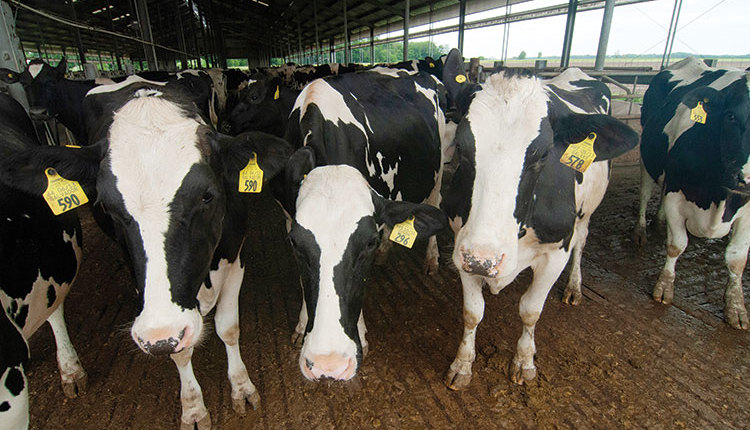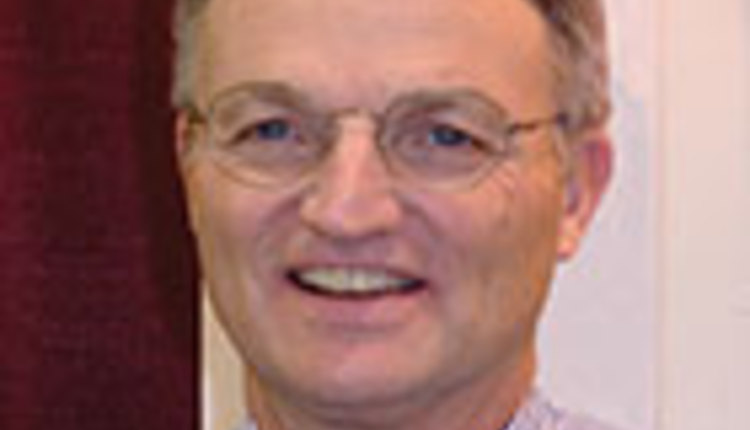The author is professor of animal sciences at Kansas State University, Manhattan.
Timed A.I. breeding programs have become very useful to dairy producers for a number of reasons, especially convenience. Profitable reproductive performance requires all nonpregnant cows to be inseminated at every eligible opportunity. To make that happen, most herds need a reliable system that includes heat detection and some timed A.I. program.
It becomes less and less possible with increasing herd size and cost of labor to examine daily every open cow for signs of estrus. To rely solely on heat detection, whether that is visual observation in addition to some type of heat detection aid, is not likely to produce the number of pregnancies that are needed every week. Even in the best scenario, about 30 percent of the eligible cows will be missed. To resolve this issue, many dairy producers have opted to use a timed A.I. program to set up the A.I. breeding of cows at first service.
Standard presynch . . .
A standard Presynch protocol + Ovsynch program is illustrated in Figure 1. Two injections of prostaglandin are administered 14 days apart, with the second Presynch injection administered between 11 and 14 days before initiating a timed A.I. program such as Ovsynch. A Presynch protocol is desirable because it presynchronizes estrous cycles, so when the timed A.I. protocol is initiated, the majority of cows are between Days 5 and 12 of the estrous cycle, an ideal time to start the timed A.I. protocol to maximize fertility. A contributing factor to this improved fertility is the greater proportion of cows that ovulate in response to the first GnRH injection of Ovsynch.

The G-6-G protocol (Figure 2) leads to a higher proportion of ovulating cows. In fact, the proportion of cows that ovulate in response to the first GnRH injection of Ovsynch is approximately 54 percent due to the random stages of the estrous cycle when Ovsynch is initiated . . . compared with 85 percent ovulation rates after cows have been setup with G-6-G.
The G-6-G protocol starts with an injection of prostaglandin to regress a mid- to late-cycle corpus luteum (CL) that may be present in the ovaries. A GnRH injection follows in two days to induce ovulation and formation of a new CL. Together, these two injections initiate a new synchronized estrous cycle and new wave of follicle growth. Six days later, a functional dominant follicle is capable of ovulation in response to another GnRH injection which is the first GnRH of a standard Ovsynch protocol. This new CL, in combination with the initial CL from the GnRH injection of the G-6-G presynch, boosts concentrations of progesterone during a seven-day period of follicular development and maturation before the timed A.I. These enhanced progesterone levels seem to have a profertility effect on the developing follicle and the egg contained therein.
The standard Ovsynch protocol is then completed with a prostaglandin injection followed in 48 to 56 hours with GnRH and timed A.I. about 16 hours later. The timing of the last GnRH sets up ovulation to occur about 24 to 30 hours later or 8 to 14 hours after semen is deposited in the uterus at A.I.
Although limited results have been published in the scientific literature by Richard Pursley, who developed the G-6-G presynch program before Ovsynch, the results look promising compared with using only the Ovsynch protocol. Combining results from two small studies, conception of 62 cows receiving the G-6-G Presynch before Ovsynch was 47 percent compared with 30 percent in 66 cows treated with only the Ovsynch protocol. According to DHIA records of commercial dairy farms using the G-6-G Presynch before Ovsynch, Ray Nebel of Select Sires, reported a modest increase in pregnancy rates.
Advantages and disadvantages of the G-6-G Presynch + Ovsynch program are in the hands of the end user. Whether one uses it or the standard Presynch + Ovsynch program, each cow must be treated with five injections before A.I. The G-6-G protocol injections, however, are on five different days of the week.
Compliance to a protocol schedule is clearly the most important issue for making any protocol successful. Good management is essential to the success of any protocol implemented on the dairy. Further, when cows show heat some time during the protocol, decisions about whether or not to A.I. breed cows in heat must be clearly communicated to everyone involved. Protocol choice depends on heat-detection efficiency, conception rates, and ability of employees to implement the protocol correctly. You have a choice.
To ensure success:
Important points to consider when using timed A.I. protocols:
1. Use 18- to 20-g, 1-1/2 inch needles for deep muscle injections of prostaglandin and GnRH.
2. Size of syringe should fit the volume of injection (for example, 3-cc syringe for 2-cc injections; 6-cc syringes for 5-cc injections).
3. Handle and store hormones according to instructions.
4. Health and cycling status of cows should be part of the decision to include cows in a timed A.I. protocol.
5. Ensure that the correct hormone is administered to the right cow at the prescribed time.
6. Double-check ear tag IDs of cows before each injection. Prostaglandin will lyse the corpus luteum and induce abortion.
Click here to return to the Reproduction E-Sources
091010_620
Timed A.I. breeding programs have become very useful to dairy producers for a number of reasons, especially convenience. Profitable reproductive performance requires all nonpregnant cows to be inseminated at every eligible opportunity. To make that happen, most herds need a reliable system that includes heat detection and some timed A.I. program.
It becomes less and less possible with increasing herd size and cost of labor to examine daily every open cow for signs of estrus. To rely solely on heat detection, whether that is visual observation in addition to some type of heat detection aid, is not likely to produce the number of pregnancies that are needed every week. Even in the best scenario, about 30 percent of the eligible cows will be missed. To resolve this issue, many dairy producers have opted to use a timed A.I. program to set up the A.I. breeding of cows at first service.
Standard presynch . . .
A standard Presynch protocol + Ovsynch program is illustrated in Figure 1. Two injections of prostaglandin are administered 14 days apart, with the second Presynch injection administered between 11 and 14 days before initiating a timed A.I. program such as Ovsynch. A Presynch protocol is desirable because it presynchronizes estrous cycles, so when the timed A.I. protocol is initiated, the majority of cows are between Days 5 and 12 of the estrous cycle, an ideal time to start the timed A.I. protocol to maximize fertility. A contributing factor to this improved fertility is the greater proportion of cows that ovulate in response to the first GnRH injection of Ovsynch.

The G-6-G protocol (Figure 2) leads to a higher proportion of ovulating cows. In fact, the proportion of cows that ovulate in response to the first GnRH injection of Ovsynch is approximately 54 percent due to the random stages of the estrous cycle when Ovsynch is initiated . . . compared with 85 percent ovulation rates after cows have been setup with G-6-G.
The G-6-G protocol starts with an injection of prostaglandin to regress a mid- to late-cycle corpus luteum (CL) that may be present in the ovaries. A GnRH injection follows in two days to induce ovulation and formation of a new CL. Together, these two injections initiate a new synchronized estrous cycle and new wave of follicle growth. Six days later, a functional dominant follicle is capable of ovulation in response to another GnRH injection which is the first GnRH of a standard Ovsynch protocol. This new CL, in combination with the initial CL from the GnRH injection of the G-6-G presynch, boosts concentrations of progesterone during a seven-day period of follicular development and maturation before the timed A.I. These enhanced progesterone levels seem to have a profertility effect on the developing follicle and the egg contained therein.
The standard Ovsynch protocol is then completed with a prostaglandin injection followed in 48 to 56 hours with GnRH and timed A.I. about 16 hours later. The timing of the last GnRH sets up ovulation to occur about 24 to 30 hours later or 8 to 14 hours after semen is deposited in the uterus at A.I.
Although limited results have been published in the scientific literature by Richard Pursley, who developed the G-6-G presynch program before Ovsynch, the results look promising compared with using only the Ovsynch protocol. Combining results from two small studies, conception of 62 cows receiving the G-6-G Presynch before Ovsynch was 47 percent compared with 30 percent in 66 cows treated with only the Ovsynch protocol. According to DHIA records of commercial dairy farms using the G-6-G Presynch before Ovsynch, Ray Nebel of Select Sires, reported a modest increase in pregnancy rates.
Advantages and disadvantages of the G-6-G Presynch + Ovsynch program are in the hands of the end user. Whether one uses it or the standard Presynch + Ovsynch program, each cow must be treated with five injections before A.I. The G-6-G protocol injections, however, are on five different days of the week.
Compliance to a protocol schedule is clearly the most important issue for making any protocol successful. Good management is essential to the success of any protocol implemented on the dairy. Further, when cows show heat some time during the protocol, decisions about whether or not to A.I. breed cows in heat must be clearly communicated to everyone involved. Protocol choice depends on heat-detection efficiency, conception rates, and ability of employees to implement the protocol correctly. You have a choice.
To ensure success:
Important points to consider when using timed A.I. protocols:
1. Use 18- to 20-g, 1-1/2 inch needles for deep muscle injections of prostaglandin and GnRH.
2. Size of syringe should fit the volume of injection (for example, 3-cc syringe for 2-cc injections; 6-cc syringes for 5-cc injections).
3. Handle and store hormones according to instructions.
4. Health and cycling status of cows should be part of the decision to include cows in a timed A.I. protocol.
5. Ensure that the correct hormone is administered to the right cow at the prescribed time.
6. Double-check ear tag IDs of cows before each injection. Prostaglandin will lyse the corpus luteum and induce abortion.
091010_620










